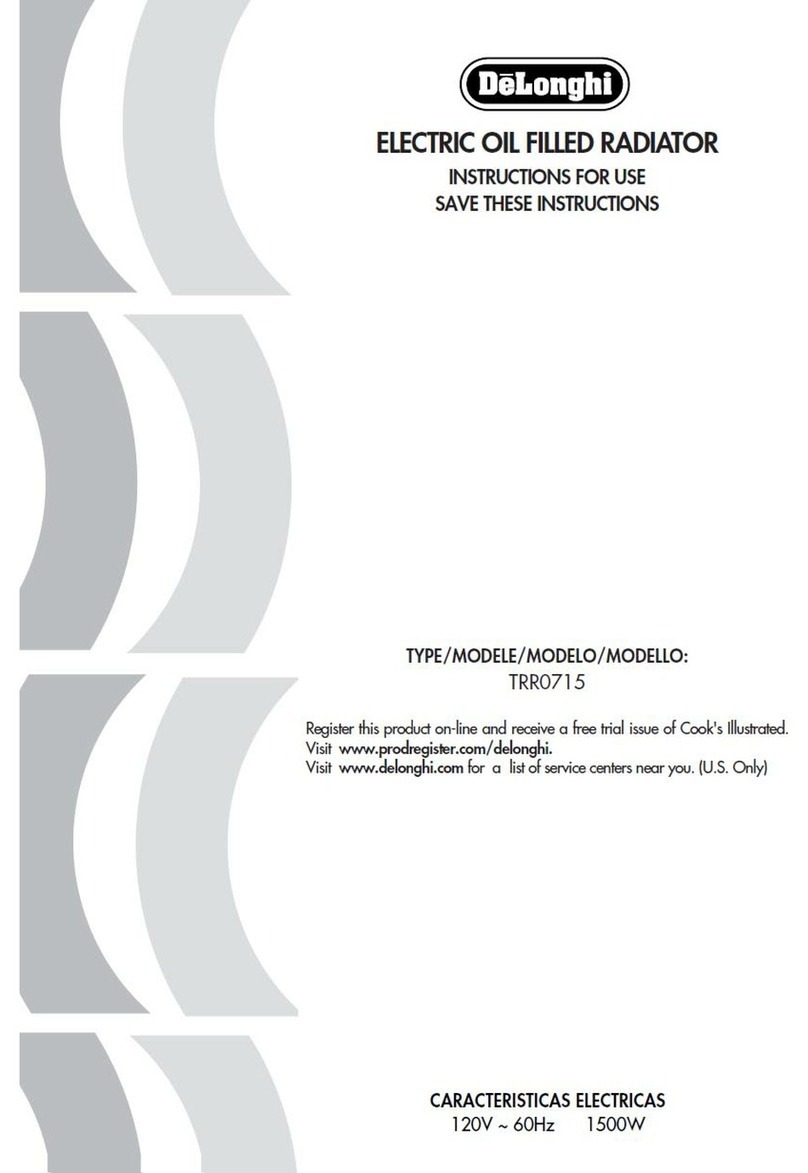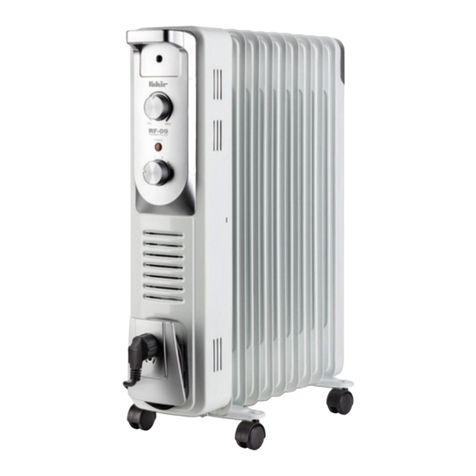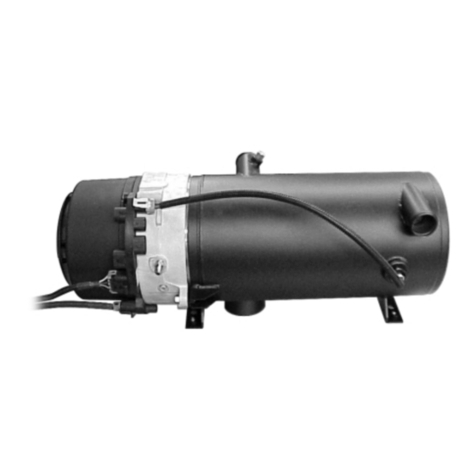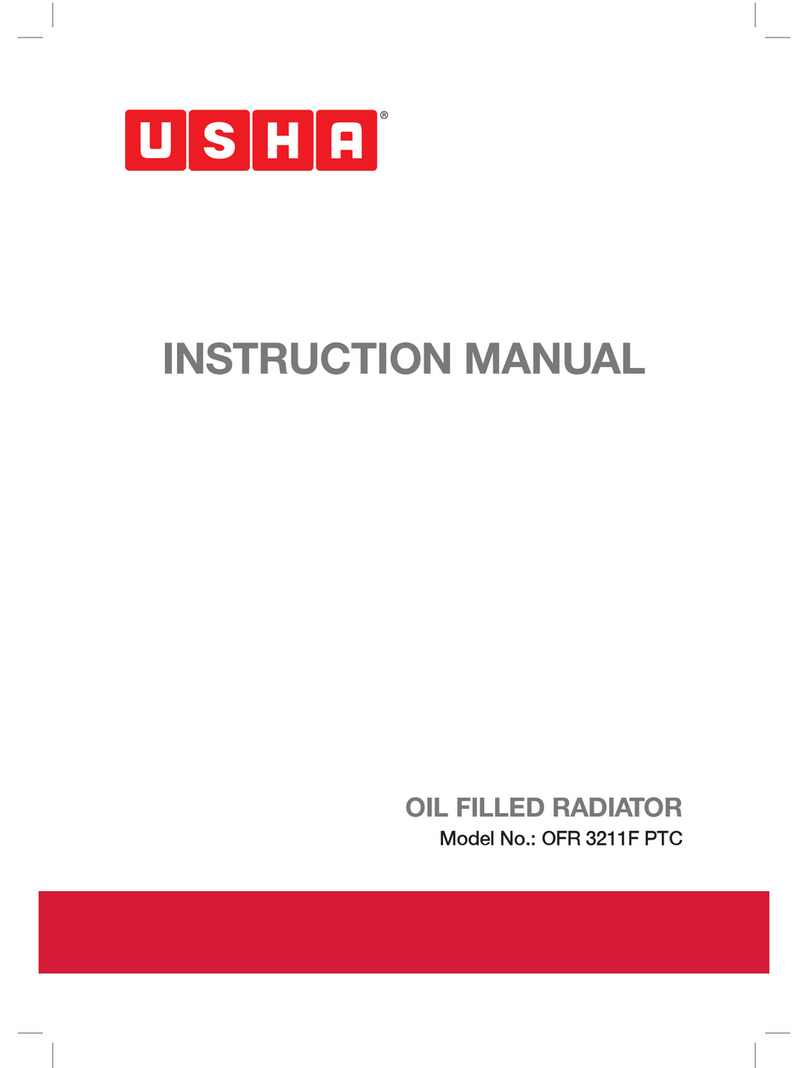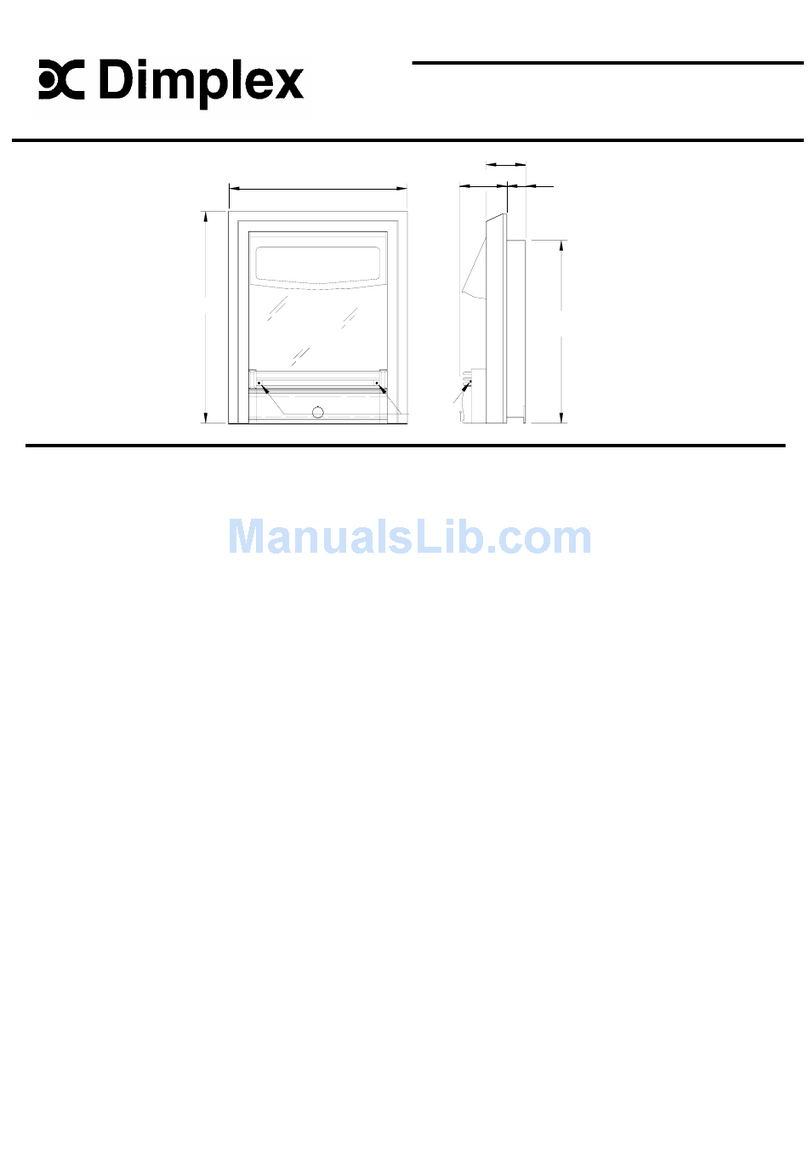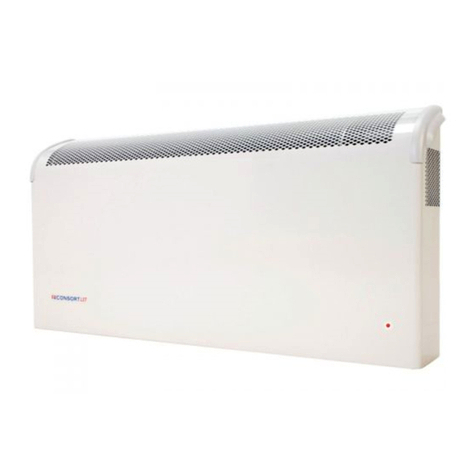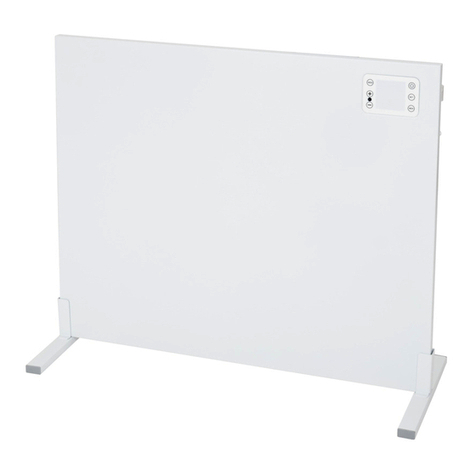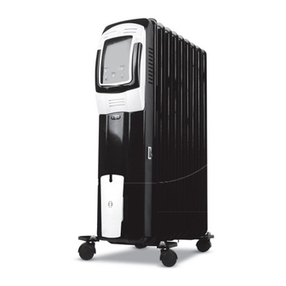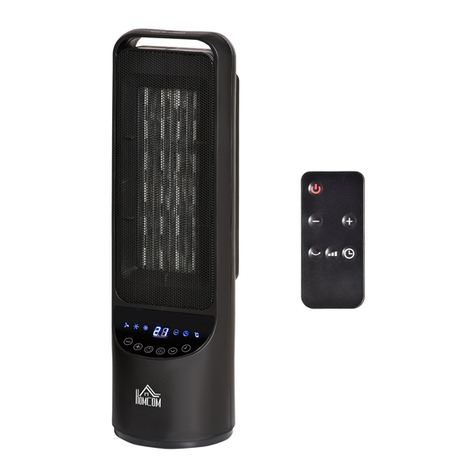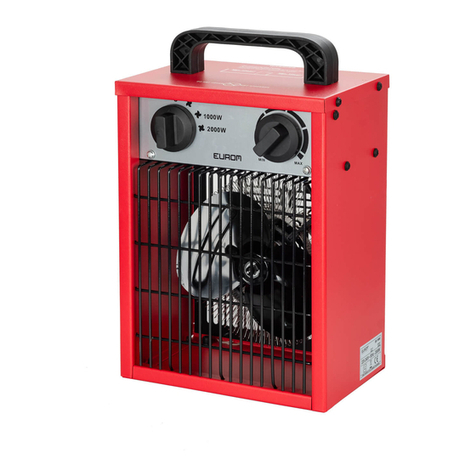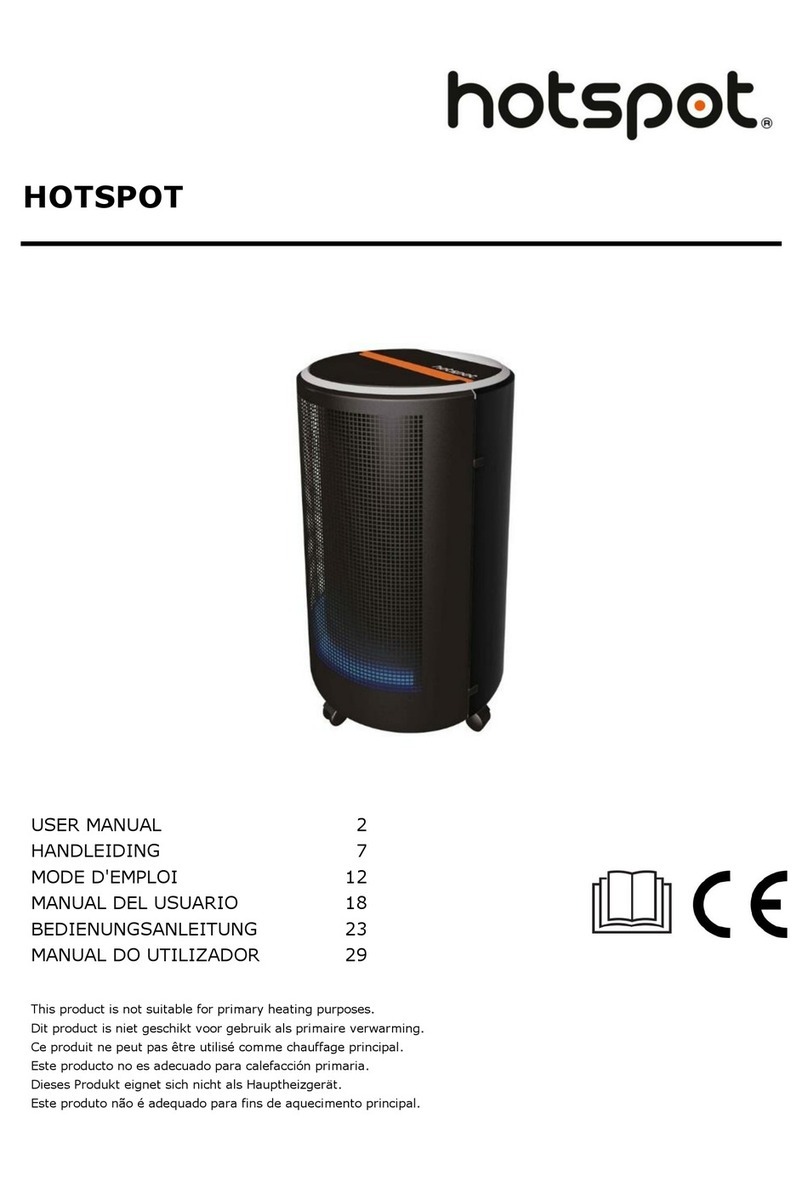Temprite Industries CMA User manual

IOMCMA-5
INSTALLATION, OPERATION AND
MAINTENANCE MANUAL FOR CMA MODEL
ATTENTION: READ THIS MANUAL AND ALL LABELS ATTACHED TO THE UNIT CAREFULLY BEFORE
ATTEMPTING TO INSTALL, OPERATE OR SERVICE THESE UNITS! CHECK UNIT DATA PLATE FOR
TYPE OF GAS AND ELECTRICAL SPECIFICATIONS AND MAKE CERTAIN THAT THESE AGREE WITH
THOSE AT POINT OF INSTALLATION. RECORD THE UNIT MODEL AND SERIAL No.(s) IN THE SPACE
PROVIDED. RETAIN FOR FUTURE REFERENCE.
4830 Transport Drive, Dallas, TX 75247 Phone: 214-638-6010 Fax: 214-905-0806
7555 Transmere Drive, Mississauga, ON L5S 1L4 Phone: 905-672-6123 Fax: 905-672-6124
www.tempriteheating.com
POUR VOTRE SÉCURITÉ
L'utilisation et l'entreposage d'essence ou d'autres liquides ou produits émettant des vapeurs
inflammables dans des récipients ouverts à proximité de cet appareil est dangereux.
FOR YOUR SAFETY
The use and storage of gasoline or other flammable vapors and liquids in open
containers in the vicinity of this appliance is hazardous.
DIRECT GAS-FIRED HEATERS WITH DDC CONTROLS
FOR YOUR SAFETY
If you smell gas:
1. Open Windows
2. Don’t touch electrical switches.
3. Extinguish any open flame.
4. Immediately call your gas supplier.
POUR VOTRE SÉCURITÉ
Si vous sentez une odeur de gaz :
1. Ouvrez les fenêtres.
2. Ne pas actionner d'interrupteur.
3. Éteindre toute flamme ouverte.
4. Appelez immédiatement votre
fournisseur de gaz.
AVERTISSEMENT : Une installation déficiente, de même qu'un mauvais réglage,
modification, entretien ou maintenance peuvent occasionner des dommages matéri-
els, corporels voire causer la mort. Lire attentivement les instructions d'installation,
d'utilisation et d'entretien avant d'installer ou d'intervenir sur cet appareil.
WARNING: Improper installation, adjustment, alteration, service or maintenance can
cause property damage,injury or death. Read the installation,operating and maintenance
instructions thoroughly before installing or servicing this equipment.
INSTALLER'S RESPONSIBILITY
Installer Please Note: This equipment has been test fired and inspected. It has been shipped
free from defects from our factory. However, during shipment and installation, problems such as
loose wires, leaks or loose fasteners may occur. It is the installer's responsibility to inspect
and correct any problems that may be found.
WARNING
Install,operate and maintain unit in accordance with manufacturer's instructions to avoid
exposureto fuelsubstancesor substances from incomplete combustion whichcancause
death or serious illness. The state of California has determined that these substances
may cause cancer, birth defects, or other reproductive harm.
c

– 2 –
*IMPORTANCE NOTICE*
Temprite assumes no responsibility for loss or damage
in transit; therefore, you should protect yourself by
following these instructions:
Bill Of Lading
Save your bill of lading. It is a contract, and you will
need it, provided you have to file a loss or damage
claim. Remember, claims are outlawed after nine
months.
Loss In Transit
Before you sign for this shipment, check against the bill
of lading, also the transportation company’s delivery
ticket. Make sure that you get the exact total of articles
listed. Should the delivery ticket show more or less
items than are offered, then the carrier’s agent must
mark the difference on your freight bill before you sign.
Visible Damage In Transit
If anything is damaged, accept the shipment only if
the carrier’s agent places a notation on your freight
bill explaining the nature and extent of damage. Upon
inspection of article, make claim to the delivering
carrier.
Concealed Damage In Transit
Sometimes transit damage is not noticed until the
goods are unpacked. In such cases, notification to
the carrier must be made within fifteen (15) days of
receipt of shipment. In such cases, save the packages
and packing material, then notify the transportation
company at once, and request an inspection. When
the inspector calls, have him make out and leave a
“concealed” bad order report. He is obliged to give one
to you. Insist on it.
Disposition Of Damaged Atticles
Never return damaged articles to us. They are the
property of the transportation company when the claim
is filed. They will give you disposition instructions.
Packing
We comply with the packing requirements of the
transportation companies, and your bill of lading
proved that everything was in good condition when
shipped. That bill of lading contract requires them to
deliver in perfect condition.
SECTION I - FOREWARD
As is the case with any fine piece of equipment, care
must be taken to provide the proper attention to the
operation and maintenance details of this machine.
This manual of instructions along with the Digital
Control System user manual has been prepared in
order for you to become well-acquainted with those
details, and in doing so, you will be able to give your
Direct Gas-Fired System the care and attention which
any piece of equipment needs and deserves.
It is the customer and installation personnel
responsibility to determine if the unit is equipped
with all of the safety devices required for the
particular application. Safety considerations
include the accessibility of the unit to non-service
personnel, the provision of electrical lockout
switches, maintenance procedures, and automatic
control sequences. Clearly mark all emergency
shutoff devices.
Table of Contents
Section I: Foreword, Table of Contents,
and Important Notice .................................. 2
Section II: General Information.................................... 3
Section III: Installation .................................................4
Section IV: Pre-Start Up ..............................................8
Section V: Unit Start Up............................................... 9
Section VI: Unit Shut Down ....................................... 11
Section VII: Troubleshooting Guide...........................12
Section VIII: Maintenance Schedule
and Lubrication Requirements............... 24
Section IX: Mestek Burner......................................... 29
Section X: Manifold and Valve Adjustments ..............30
Section XI: Thermistor Curves................................... 31
Section XII: Replacement Parts................................. 32
Section XIII: Recirculating Units ................................ 32

– 3 –
SECTION II - GENERAL INFORMATION
A. Purpose
The purpose of this manual is to present a guide for
proper installation, maintenance, and operation of the
Direct Gas-Fired System, and supplement, but not to
replace, the services of qualified field service person-
nel to supervise the initial start-up and adjustment
of the unit. Persons without previous experience with
large commercial and industrial heating equipment
should not attempt the initial adjustment and checkout
procedure which is essential before such installations
may be considered ready for operation. This manual
should be made readily available to all operating per-
sonnel as an aid in troubleshooting and proper mainte-
nance.
B. Shipping
Base Direct Gas-Fired units are shipped completely
assembled where shipping limitations allow. Optional
inlet hoods, filter and/or damper sections, or other
large accessories are assembled and shipped mount-
ed and wired whenever possible within limitations
of shipping and handling. Any optional accessories
shipped separately are shipped as assembled sec-
tions. Any wired accessories which have been disas-
sembled for separate shipment require no additional
conduit or wire for field reassembly. All wire leads will
be tagged for ease of reconnection in the field.
If the unit and/or accessories cannot be installed
immediately, they should be stored in a clean dry
environment. If this is not possible and the unit
must be stored outdoors, it should be protected
from the weather with tarpaulins or plastic
coverings. Do not assume that simply covering a
unit will keep insects, dust and condensation out
of the unit and critical components. Rotate the
fan(s) monthly.
Prior to beginning installation of a unit that has been in
storage for weeks or months, the unit and its compo-
nents should be closely inspected.
Shipments are made F.O.B. Dallas, Texas by flat-
bed truck. The unit is securely strapped, tied, and
blocked to prevent shipping damage. All shipments
are checked by an inspector before they are accepted
by the carrier. Parts that are shipped unmounted are
noted on the bill of lading. These parts, where feasible,
are packaged and shipped with the units. Upon receipt
of shipment, all units should be checked against the
bill of lading to insure all items have been received. All
equipment (and any optional accessories) should be
checked carefully for physical damage in the presence
of the carrier’s representative. If parts are missing or
damage has occurred, a claim should be filed immedi-
ately with the carrier.
All Direct Gas-Fired units are given a complete opera-
tions test and control circuit checkout before shipment.
Copies of the wiring diagram, piping diagram and
bill of material are included with each unit shipped. If
correspondence with the factory is necessary, please
provide the unit model and serial number.
C. Optional Factory Service
Periodic service on any piece of mechanical equip-
ment is necessary for efficient operation. A nationwide
service support network is available to provide quick
and dependable servicing of make-up air, heating,
ventilating, or air handling types of equipment. Factory
start-up service is also available which includes the
presence of a service engineer to supervise the initial
start-up and adjustment of the equipment and provide
instructions for the owner’s maintenance personnel in
proper operations and maintenance. Consult factory
for quotations on start-up or periodic service.

– 4 –
SECTION III - INSTALLATION
During transit, unloading and setting of the unit, bolts
and nuts may have become loosened, particularly
in the pillow block ball bearing assemblies in the fan
section. It is recommended that all nuts and set screws
be tightened. Turn fan shaft by hand to make certain
that blower does not rub against blower housing, and
that bearing set screws are tight. If units are not set
immediately, cover all openings that might be exposed
to the weather.
Open the cover on the electrical control box located on
the unit. Inspect all wire terminals and wiring termina-
tions to ensure that all connections are tight.
If units are not set immediately, cover all openings that
might be exposed to the weather.
Rotate fans monthly.
RIGGING AND MOUNTING DATA - DIRECT FIRED UNITS
WARNING: To insure that a proper unit lift is
made, lift unit approximately 24 inches and
verify proper center of gravity lift point.To avoid
dropping of unit, reposition lifting point if unit
is not level. Failure to properly lift unit could
result in death or serious injury or possible
equipment or property-only damage.
FOR CANADIAN INSTALLATIONS ONLY
1. All installations must conform with local building
codes, or, in the absence of local codes, with
current CAN/CGA-B149-Installation Codes For
Gas Burning Appliances and Equipment.
2. All electrical connections must be in accor-
dance with Canadian Electrical Code, Part 1,
CSA Standard C22.1.
This equipment must be installed and wired in ac-
cordance with regulations of the National Board of
Fire Underwriters, National Electrical Code, and local
governing bodies. The following recommendations are
not intended to supplant any requirements of federal,
state, or local codes having jurisdiction. Authorities
having jurisdiction should be consulted before instal-
lations are made. Local codes may require additional
safety controls and/or interlocks.
All installations in airplane hangers must be in ac-
cordance with current ANSI/NFPA No. 409. All instal-
lations in public garages must be in accordance with
current NFPA No. 88A and NFPA No. 88B.
CAUTION: Do not install heating system in corrosive
or flammable atmospheres! Premature failure of, or
severe damage to the unit will result!
CAUTION: Heating system must not be installed in
locations where air for combustion would contain
chlorinated, halogenated or acidic vapors. If located
in such an environment, premature failure of the
unit will occur!
A. Handling the Equipment
The Direct Gas-Fired unit has been designed for
rigging and handling through the use of special lifting
lugs installed on the sides of each unit. As explained
previously, the basic unit is designed for shipping in
one piece where shipping limitations allow. Some
optional accessories may require field mounting.
The Direct Gas-Fired unit has been designed for
rigging and handling through the use of special lifting
lugs installed at each corner of unit. When unloading
and setting the unit, use the lifting lugs provided or
move the equipment on rollers. Hooks, jacks, or chains
must not be used around the casing, main control
panel or exterior mounted controls.
LIFTING LUGS
PROVIDED IN ONE
OF TWO LOCATIONS
AA
B
B
A - USE WHEN LIFTING OVER 3,000 LBS.
B - USE WHEN LIFTING UNDER 3,000 LBS.
08/16/07 C000539A
SPREADER
BAR
SPREADER
BAR

– 5 –
B. Locating the Unit
Prior to locating the unit, authorities having jurisdic-
tion should be consulted before installations are made.
Approval permits should be checked against the unit
received.
On Direct Gas-Fired units, which recirculate room air,
outside ventilation air must be provided in accordance
with the information shown on the heater nameplate.
All ventilation air to the heater must be ducted directly
from the outside. See Section XIII.
If in doubt regarding the application of this appliance,
consult the factory.
Locate the unit exactly level. Special attention should
be given to the duct, electrical, and fuel connection
points. Install duct work with adequate flexible connec-
tions to isolate vibration from the duct work. All duct
work should have taped or caulked seams. Duct work
should be properly sized so as not to inhibit airflow.
This information should be cross-checked with the
position of support beams and stand pipes to insure
that clearance dimensions coincide with those of the
unit. The minimum clearance to combustible material
must be maintained as listed in Table 1.
Table 1
Minimum clearance to combustible material,
also consult local codes and regulations.
Clearances to Combustible Material
Vertical Units Horizontal Units
Front* 39 inches 36 inches
Rear 6 inches 6 inches
Right 6 inches 6 inches
Left 6 inches 6 inches
Top 12 inches 12 inches
Floor Zero 6 inches
*Consider control side as front of unit.
**Optimum clearance for shaft removal would be
equivalent to cabinet width.
Make a visual inspection to insure no damage has oc-
cured to the unit during installation.
C. Curb Mounted Units
Outdoor units can be supplied with an optional roof
curb. The curb greatly facilitates installation thereby
reducing installation costs. All connections to the unit:
duct, piping, electrical power and control wiring can
be made through the roof opening. The curb may be
shipped prior to unit shipment. All curbs are shipped
un-assembled from the factory.
Use extreme caution in handling the curb. Proper
handling and positioning will assure a water-tight curb
unit installation.
Re-check approval prints prior to installation. Be sure
that there are no obstructions to ducting and that
proper planning has been exercised in connection of
piping and/or electrical services.
The curb assembly may be bolted or welded to either
trusses or roof decking; however, connection to roof
trusses is recommended. The curb is designed to carry
the weight of the unit. Additional support is required for
certain applications.
Placement of the curb is critical in squareness and
leveling. Shims for leveling must be applied to the
curb; application of shims to the unit will tend to
destroy the sealing effect after installation. Make sure
sealing tape is in place before unit is set. Be careful
not to allow gaps where two pieces of sealing tape
meet. A bubble level must be used in the leveling
process. Measure across diagonals to check for
squareness. Allowable tolerance is 1/4" difference
between diagonal measurements. Double-check
approval prints before setting the unit.
Upon completion of setting the curb, apply roofing
material and flashing as required. On outdoor curb
mounted installations, flash and seal the roof curb to
prevent leakage. The cross section of factory provided
curb is formed to accept wood nailing strip and insula-
tion provided by others.
D. Location of Accessories
Where applicable, standard or optional accessories will
be placed inside the fan section of the unit for shipment,
and must be removed and installed by the mechanical
or electrical contractor.
Remotely located discharge or inlet dampers must be
equipped with an end switch and interlocked to insure
maximum design opening before starting and running
circuits may be energized.
Field constructed intake accessories should be properly
designed to minimize the entry of rain and snow.
Adequate building relief must be provided, so as to not
over-pressurize the building, when the heater is
operating at its rated capacity. This can be accom-
plished by taking into account, through standard
engineering methods, the structure’s designed infiltra-
tion rate, by providing properly sized relief openings,
by interlocking a powered exhaust system, or by a
combination of these methods.

– 6 –
E. Electrical Connections
WARNING: Open all disconnect switches and
secure in that position before wiring unit.
Failure to do so may result in personal injury or
death from electrical shock.
WARNING: Controls must be protected from
water. Do not allow water to drip on the ignition
system.
NOTE: Before installing any wiring, check the unit
rating plate for supply power voltage and minimum
ampacity.
All electrical connections must conform to the current
edition of: ANSI/NFPA No. 70 National Electrical Code
and applicable state and local codes; in Canada, to the
Canadian Electrical Code, Part 1 CSA Standard C22.1
and applicable provincial and local codes.
Since shipment of unit may require disassembly after
factory check and test, reconnection of some electrical
devices will be required in the field. Connect electrical
wires (supplied in factory furnished conduit) to appro-
priate terminals. All leads are tagged to facilitate field
connections. See wiring diagram provided with equip-
ment. Complete all wiring to any optional accessories
as shown on unit bill of material and electrical wiring
diagram as required before applying voltage to the unit.
Entry location for all field-installed and control wiring is
through the control panel.
If optional disconnect is not furnished with heater, the
field provided disconnect must be of the proper size
and voltage. Refer to unit rating plate for minimum
circuit ampacity and voltage. The disconnect must be
installed in accordance with Article 430 of the current
edition of ANSI/NFPA No. 70 National Electrical Code.
Check the supply voltage before energizing the unit.
The maximum voltage variation should not exceed
± 10%. Phase voltage unbalance must not exceed 2%.
NOTE: Should any original wire supplied with the
heater have to be replaced, it must be replaced
with wiring material having a temperature rating of
at least 105° C.
REMARQUE : Dans le cas où un quelconque des
câbles livrés avec l'unité devait être remplacé, il
doit être remplacé avec des câbles prévus pour
résister à une chaleur d'au moins 105° C.
F. Field Piping
Gas Piping
All gas piping must be in accordance with the require-
ments outlined in the National Fuel Gas Code - ANSI
Z223.1. It is required that a ground union be installed
adjacent to the manifold for easy servicing. A drip leg
and/or filter should be provided upstream of the unit’s
inlet gas connection. An additional shut-off must be
located external of the unit’s enclosure. The location of
this valve must comply with all local codes. A 1/8 inch
N.P.T. plugged tapping, accessible for test gauge con-
nection, must be installed immediately upstream of the
gas supply connection to the unit.
WARNING: To avoid equipment damage or
possible personal injury, disconnect gas piping
to this unit until a supply line pressure/leak test
has been completed. Connecting the unit before
completing the pressure/leak test may damage
the unit gas valve and result in a fire hazard.
DANGER: Never use an open flame to detect
gas leaks. Explosive conditions may exist which
would result in personal injury or death.
On vertical units there is a factory installed “Burner
Cleanout” pipe located on the opposite end of the gas
piping compartment. This is a clean out to drain any
condensate that may have collected in the line burner.
WARNING: DO NOT connect supply gas to this
pipe.
The gas line should be supported so that no strain
is placed on the unit. Pipe compounds which are not
soluble to liquid petroleum gases should be used on
threaded joints.
Refer to the heater’s rating plate for determining the
minimum gas supply pressure for obtaining the maxi-
mum gas capacity for which this heater is specified.
Une tuyauterie adéquatement dimensionnée doit être
posée jusqu'à l'unité. Veuillez noter que la pression de
la tuyauterie d'alimentation en gaz doit correspondre
à celle spécifiée sur la plaque d'identification, lorsque
l'unité fonctionne à plein rendement.
Refer to the heater’s rating plate for determining the
maximum supply pressure to the heater.
The appliance and its individual shutoff valve must
be disconnected from the gas supply piping system
during any pressure testing of that system at test
pressures in excess of 1/2 PSIG.

– 7 –
The appliance must be isolated from the gas supply
piping system by closing it’s individual manual
shutoff valve during any pressure testing of the gas
supply piping system at test pressure equal to or
less than 1/2 PSIG.
Correctly sized piping must be run to the unit.
Please note that gas line pressure must be
as shown on specification plate when unit is
operating at full input.The high-pressure regulator
and relief valve should be, if possible, mounted
at least 5 to 10 feet upstream from the appliance
regulator on the unit (if possible).
Building Pressure Transducer Piping (PT-13)
Pipe the high side to location inside the building that
will not be affected by air movement. Pipe the low side
to the atmosphere, positioned so it will not be affected
by the wind and not exposed to the elements. Be sure
that all tubing is clean and clear of any debris before
installing tubes on the transducer.
Flow Station Transducer Piping (PT-15)
Pipe the high side to the upstream connection and
low side to the downstream connection of the Airflow
Station as shown in Drawing # C000643 below. Be
sure that all tubing is clean and clear of any debris
before installing tubes on the transducer.
G. Field Wiring and Remote Control Installation
1. Connect the power lines to the line side of
the power distribution block or optional main
disconnect switch.
2. Field wiring is typically indicated on the wiring
diagram as dashed lines. When running any field
wiring for control circuit be sure wire is sized for
a maximum 10% voltage drop. Check the VA
rating of control circuit transformer to determine
maximum load.
3.
Mount and wire remote control panel, thermostats,
temperature sensors, and any other field installed
controls as indicated on the unit control wiring diagram.
4.
Connect all wires to the appropriate field wiring
terminals and any shielded or twisted wires as indicated
on the unit control diagram.
5. Field wiring shall have a temperature rating of at
least 105°C. The minimum size of the supply cable
circuit shall be sufficient for the maximum ampacity
of the heater.
L'installation éléctrique d'utilisateur aura une
température qui évalue d'au moins 105°C. La
minimum de source du circuit de câblage sera
suffisante pour le ampacity maximum de l'appareil
de chauffage.
H. Locating Temperature Controls
The room or outdoor sensors should be mounted
where they will not be subjected to direct impact of
the heated air or radiant heat from the sun. It is also
recommended that thermostats, especially those with
mercury bulb contacts, be mounted on a vibration free
surface. The side of building columns away from the
heater or interior walls are usually the location best
suited for mounting thermostats.
Controls with outdoor sensors require that the outdoor
sensor be shielded from direct radiation from the sun. Unit
mounted sensors are factory located and mounted.
AMPLIFIER WING
(SHEET METAL STRIP)
TOTAL PRESSURE
SENSING TUBE
BULLET
STATIC PRESSURE
SENSING TUBE
HIGH PRESSURE
TUBE CONNECTION
LOW PRESSURE
TUBE CONNECTION
AIRFLOW STATION LAYOUT
C000643
AIRFLOW STATIO N
EXTERIOR INSULATION
FIELD PROVIDED WHEN
MOUNTED OUTDOORS
RA DAMPER
HEATER
CASING
NOTE: RUN TUBE CONNECTIONS
TO TRANSDUCER (PT-15) IN
UNIT CONTROL ENCLOSURE

– 8 –
SECTION IV - PRE START-UP
Do not attempt start-up without completely reading
and understanding this manual, along with the
Digital Control Sysem user manual.
A. Pre Start-Up
The owners representative or equipment operator
should be present during start-up to receive instruc-
tions on care and adjustments of the equipment.
All equipment has been factory tested, adjusted,
metered and inspected to meet conditions set at
the time the order was placed. Only minimal
adjustments should be required. All information
in this service manual is typical. All products are
semi-custom and changes may occur.
Suggested Tools and Instruments
Volt/Ohm Meter Thermometer
Tachometer Ammeter
Manometer (0-10" W.C.) Microammeter
Standard Hand Tools D.C. Volt Meter
Gas Pressure Gauge (0-35 lbs.) BACview 6
CAUTION:Line side of disconnect may be energized.
Follow proper “lockout/tagout” procedures.
NOTE: All servicing and adjustments of the Direct
Gas-Fired unit should be performed by a qualified
service engineer.
Perform a visual inspection, internally and externally,
to make sure no damage has occured and that
everything is secure. This inspection is very important
and should be completed with greatest care given to
detail. A good pre-start inspection will insure against
possible unit damage on start-up and will save
valuable analysis time.
1. Check that the physical condition of the unit
exterior is acceptable.
2. Check that the insulation inside of unit is properly
secured.
3. Remove all shipping blocks, brackets and bolts
from supply fan base with optional isolation base.
4. Check all wiring for loose connections and tighten
if necessary.
5. Inspect all fan and motor bearings and lubricate if
necessary.
CAUTION: DO NOT RUPTURE GREASE SEALS.
6. Inspect pulleys and belts for tightness, tension and
alignment. Do not overtighten belts.
7. Check set screws on all bearings, pulleys, fans and
couplings for tightness.
8. Check voltage supplied to disconnect switch; the
maximum voltage variation should not exceed
± 10%. Phase voltage unbalance must not exceed 2%.
9. Check thermostat(s) for normal operation.
10. Check that system duct work is installed and free
from obstructions.
11. Check that fans turn free in housing.
12. Check that the area around the unit is clear of
flammable vapors or containers of flammable
liquids.
13. Check that all piping connections, particularly
unions, are tight. Check all gas piping for leaks
using a soap bubble solution. The most common
types of problems found relative to the gas train
itself is foreign material within the gas piping. This
will interfere with the proper operation of the gas
train components and burner. Purge all air from
gas lines per gas codes.
14. Check that all accessories requiring field wiring
have been properly installed.
15. Check burner for proper location and alignment.
16. Check that filters, filter stops, accessories and ship
loose items are installed correctly.
17. Check that vent lines (if applicable) are run to
atmosphere on gas regulators and pressure
switches for indoor units. Vent lines should
terminate outside the building, with a turndown
elbow and bug screen. Note that some units will
use vent limiters and vent lines are not required.
If vent lines are even partially plugged, this will
interfere with proper venting of pressure control
devices.
18.
Check that all manual gas shut-off valves are closed.
19. When failure or malfunction of this heater creates a
hazard to other fuel burning equipment, (e.g. when
the heater provides make-up air to a boiler room),
the heater is to be interlocked to open inlet air
dampers or other such devices.
20. Motor overload relay setting should match the
motor’s nameplate full load amperage.
21. Check that dampers and linkages are free to move,
and that linkages are tight.
22. The unit may require that a Return Airflow Station
be field installed. Be sure all tubing connections
are in the correct location as shown in drawing
#C000643.
23. Check to ensure all manual reset safety devices
have been reset and limits are in the normal
operating position.
24. If inlet duct is attached to the heater, a purge
timer must be provided and set to purge 4
times the inlet duct volume.
Purge time in seconds = 4 x L x W x H x 60
SCFM
L = duct length in feet, W = duct width in feet,
H = duct height in feet, SCFM = rating plate air
throughput.
Refer to the electrical schematic for the proper
circuit placement. Purge timer P/N 65.0711.00.

– 9 –
SECTION V - UNIT START-UP GENERAL
Before attempting to start the heater read and
understand the the sequence of operations
electrical schematic, ignition module, control
components, gas train, burner and the Digital
Control System user manual.
WARNING: During installation,testing, servicing
and trouble shooting of this product, it may
be necessary to work with live electrical
components. Have a qualified licensed
electrician or other individual who has been
properly trained in handling live electrical
components to perform these tasks. Failure to
follow all electrical safety precautions when
exposed to live electrical components could
result in death or serious injury.
Make sure all manual gas valves are closed.
Make sure all doors and service panels have been
closed or replaced.
Turn main disconnect switch off. Check the incoming
line voltage to match unit rating plate rating. If voltage
is over ±10% of nameplate rating or phase voltage
unbalance is over 2%, notify contractor or power
company.
Fans Are Enabled And Disabled By The Following:
MDT And MRT Standard:
By rotating the remote “Temperature Setpoint” knob
(MP-15).
Clockwise will enable the fans.
Counterclockwise will disable the fans.
MRT-PRO With Smart Room Sensor:
To enable the fans and place the unit in the Occupied
Mode press the “Manual On” button on the face of
the (TS-02) MRT-PRO room sensor. Pressing the
“Warmer” button will add 30-minute increments of
time for a total of 9-hours of operating time. To disable
the fans and place unit in the Unoccupied Mode press
and hold down the “Manual On” button. Alternately
pressing the “Manual On” button will also decrease
the amount of operating time until it reaches zero and
turns the fan off.
MRT Expert or VDT Expert With A BACview (KP-01):
To enable the fans go to “Unit Modes” and enter
[MANUAL], this mode will enable the fans.
To also enable the fans go to “Unit Modes” and enter
[AUTO], this mode has four different functions that
control the fans and unit operation. They are a Time
Clock, Heating and Cooling Night Setbacks, and signal
from an external source to an auxiliary digital input.
To disable the fans go to “Unit Modes” and enter
[OFF].
NOTE: A BACview or PC is required to change Unit
Modes. For a more detailed control sequence see
the (Digital Control System User Manual).
Turn main disconnect switch on and Enable fans.
Damper opens (if applicable). After end switch has
proven damper is open, the blower fan turns on.
(see operating modes in Digital Control System user
manual)
Disable the fans. Check supply blower for proper
rotation.
NOTE: To change rotation of the blower, simply
interchange any two (2) of the line leads of the
motor starter for three (3) phase motors. On single
phase motors refer to motor nameplate.
Enable the fans. Check for proper blower rpm. Check
that all motor amp draws do not exceed rating plate
ratings and overloads are set to motor rating plate
amps.
Check all dampers for proper operation, and linkage
does not bind, see “Sequence of Operation”, and
Digital Control System user manual for damper control
modes.
Disable the fans.
NOTE: Before attempting to light the main burner
you need to review Section X for proper Manifold
and Valve Adjustments. A BACview 6 or PC will be
required to change setpoints.
Check the gas supply pressure by replacing the plug
fitting on the gas line with a pressure gauge having
appropriate range, and opening the manual gas
valve. Check that the pressure reading is within the
specified range on the rating plate.
NOTE: To adjust gas pressure on supply lines
where a regulator has been installed (to reduce the
inlet pressure to rating plate maximum pressure),
remove dust cap of main gas regulator and turn
adjusting screw clockwise to increase pressure or
counter-clockwise to decrease pressure.
Connect a DC Microammeter between SENSE
terminal and flame rod sensing wire.

– 10 –
Open first main gas shut-off valve slowly. Reset high-
low gas pressure switches (if applicable). Check main
gas line for leaks using soap solution.
Heat is Enabled By The Following:
MDT And MRT Standard:
To enable the heat, rotate the “Temperature
Setpoint” knob (MP-15) clockwise to the desired
setpoint above the actual air temperature. The
allowable temperature range is 55oto 90oF.
MRT-PRO With Smart Room Sensor:
To enable the heat, press the “Warmer” or “Cooler”
button on the face of the remote MRT-Pro room sensor
(TS-02) to the desired room setpoint. Each push of the
button changes the temperature setpoint by 1oF. The
setpoint can be changed a maximum of + 10oF from
the default of 65oF. Changing the heating setpoint
also changes the cooling setpoint.
MRT Expert or VDT Expert With A BACview (KP-01):
To enable the heat for MRT Expert scroll through
the “Setpoints” menu in the BACview and enter the
desired room Heating Occupied and Unoccupied
Setpoints. For VDT Expert enter the desired Heating
Discharge Air Setpoint.
Energy Savings Modes:
There are 3 Energy Savings Modes that could
disable the burner.
NOTE: A BACview or PC is required to change
Setpoints. For a more detailed control sequence,
see the Digital Control System Users Manual.
Setting Main Flame
CAUTION: You will have approximately three (3)
minutes before the unit shuts down on Freezestat
(Low Discharge Temperature, if you have
disconnected plug wires TS-01 and TS-03). Referred
to in Section X.
NOTE: 3 OR 4 TRIALS MAY BE NEEDED TO
PURGE AIR FROM GAS LINE.
United Technologies Electronic Controls Spark
Ignitor (RE-02)
Watch microammeter carefully. Burner must hold in low
fire for approximately 10 seconds before modulating
up. The reading should be at least 0.5 microamps.
If the read-ing is too low, slowly turn the low-fire
adjustment on the modulating valve in or out until
satisfactory readings are obtained. When adjusting
low fire, there should be a continuous flame along the
entire burner length without any blowout spots.
Install manometer at test port on the last tee of the
burner manifold, or MR valve test port.
Slowly open last manual gas shut-off valve.
Enable the fan and burner. Unit will run for 5 seconds
before valve opens and burner lights if all safeties and
limits are in normal operating mode.
NOTE: This is a direct spark ignition burner. Low
fire may need to be adjusted first in order to light
the burner.
Adjust high fire pressure reading (from manometer) to
match Normal Manifold Pressure firing rate shown on
unit rating plate.
Refer to Valve Adjustment instructions in Section X
for setting high and low fire gas pressure settings.
The high fire setting must be made before adjusting
low fire. Adjust the high fire setting according to the
Maxitrol Valve Adjustment instructions in Section X.
The high fire setting must not exceed the pressure
stated on the rating plate.
When adjusting low fire, there should be a
continuous flame along the entire burner length
without any blowout spots. Burner must hold in low
fire for approximately 10 seconds before modulating up.
Check flame signal with burner cycling through full firing
range.
Cycle burner several times to insure smooth light off.
Low fire may need to be readjusted.
There should be a continuous spark for ten (10)
seconds with the last gas cock turned off and the
ignition control (RE-02) should lock out.
Check main gas lines for leaks.
Main flame is now set. Make sure burner modulates
and turn thermostat to the desired setting.

– 11 –
SECTION VI - UNIT SHUTDOWN
A. Extended Shutdown —
1. Disable the heating and cooling for 30 seconds,
then disable the fan.
2. Close all manual gas valves.
3. Open the main electrical disconnect switch.
B. Emergency Shutdown ONLY —
1. Open the main electrical disconnect switch.
2. Close the main manual gas valve.
Safety Controls Check All
A. Ignition Control (RE-02) – Close last manual gas
valve before main burner. Operate unit in Heat mode.
The ignition control must lock out within approximately
15 seconds.
B. High Temperature Limits and Firestats – These limit
controls are not adjustable and are checked at the
factory. Reset the button(s) to be sure they are ready
for operation. Contact factory if these switches fail to
reset.
C. Gas Pressure Switches – The low pressure switch
will trip out and must be reset before resuming op-
eration when the inlet gas valve is turned off during
operation. The high pressure switch may be checked
out by reducing the setting of its trip point to unit oper-
ating pressure. It should then trip out and shut off the
burner. Return the adjustment to its original setting and
reset to resume operation.
D. Air Pressure Switches – The high air pressure
switch is checked by removing the sensing tube
from the entering air side of the burner and gently
blow into the switch connection. Switch operation
will shut off the burner. Recycle is automatic when
the sensing tube is replaced. The low air pressure
switch is checked by removing the sensing tube from
the leaving air side of the burner. Switch operation
will shut off the burner. Recycle is automatic when
the sensing tube is replaced. Do not adjust air flow
switches.
E. Adjustable temperature and limit Controls – The
limit controls are checked by adjusting control
settings to a lower temperature setting while the unit
is operating on high fire and observing cutoff. The
controls should be reset to settings shown below:
Make sure all the safeties and controls are working
properly.
Suggested Control Settings
(Refer to Digital Control System user manual for default settings)
TS-02
Space Temperature Sensor ..... Customer Discretion
KP-01
Keypad/Display Module ........... Customer Discretion
MP-05
Damper Control Potentiometer
... Customer Discretion
MP-15
Unit Enable Potentiometer ....... Customer Discretion
PS-04
Low Gas
Pressure Switch .........................................1.0" W.C.
PS-07
High Gas
Pressure Switch ........ 125% above burner firing rate
PS-12
Clogged Filter Switch ............
Adjust to field condition
PT-13
Building Pressure Transducer .. Adjust to field condition
FL-02
High Temperature Limit (Manual)................... 185° F
Cooling is Enabled By The Following:
MDT And MRT Standard:
To enable the cooling, rotate the “Temperature
Setpoint” knob (MP-15) clockwise to the desired
setpoint below the actual air temperature. The
allowable temperature range is 55oto 90oF.
MRT-PRO With Smart Room Sensor:
To enable the cooling, press the “Warmer” or
“Cooler” button on the face of the remote MRT-Pro
room sensor (TS-02) to the desired room setpoint.
Each push of the button changes the temperature
setpoint by 1oF. The setpoint can be changed
a maximum of + 10oF from the default of 73oF.
Changing the cooling setpoint also changes the
heating setpoint.
MRT Expert or VDT Expert With A BACview (KP-01):
To enable the cooling for MRT Expert scroll through
the “Setpoints” menu in the BACview and enter the
desired room Cooling Occupied and Unoccupied
Setpoints. For VDT Expert enter the desired Cooling
Discharge Air Setpoint.
Energy Savings Mode:
Energy Savings Mode 4 can disable the cooling.
NOTE: The cooling outputs are protected by an
anti-cycle timer which has a 3 minute off/3 minute
on delay. A BACview or PC is required to change
Setpoints. For a more detailed control sequence,
see the Digital Control User Manual.

– 12 –
SECTION VII - TROUBLE SHOOTING
Check Safety Shutdown Performace
WARNING: Fire or explosion hazard. Can
cause property damage, severe injury or death.
Perform the safety shutdown test any time work
is done on a gas system.
NOTE: Read steps 1 through 7 before starting, and
compare to the safety shutdown or safety lockout
tests recommended for the intermittent ignition
module. Where diffferent, use the procedure
recommended for the module.
1. Turn off the last manual gas cock.
2. Adjust setpoint above room temperature to call for
heat.
3. Watch for ignition spark following prepurge. See
ignition module specifications.
4. Time the length of the spark operation. See the
ignition module specifications.
5. After the module locks out, open the manual gas cock
and make sure no gas is flowing to the main burner.
6. Reset the ignition control relay (RE-02).
7. Operate system through one complete cycle to
make sure all controls operate properly.
United Technologies Electronics Control Operation
of the Series 1016-400 Direct Spark Ignition
Control (RE-02)
On a call for heat a five second pre-purge is initiated.
Upon completion of the pre-purge, the gas valve and
60Hz spark are energized. When flame is detected,
the control enters the steady state heating condition.
Steady state heating will continue until the call for heat
is satisfied.
If ignition is not achieved within 15 seconds, the control
shuts off the gas and locks out. If the trial for ignition has
been accomplished without ignition, the control shuts off
all outputs and enters lockout. Reset is accomplished
by cycling the power off for a minimum of 5 seconds. If
flame is lost once it has been established, the control will
shut off the gas valve within 0.8 seconds and locks out.
If flame is sensed during a purge period when no flame
should be present, the control will remain in purge with
the gas valve off until the false flame disappears. If the
gas valve is found to be powered when it should be off, or
not powered when it should be on, the ignition control will
enter lockout with all outputs off. Reset is accomplished
by cycling the power off for a minimum of 5 seconds.
The Red LED Diagnostics codes are:
Steady Off: No power or control hardware fault
Steady On: Power applied, control OK
1 Flash: Burner failed to light
2 Flashes: Flame was established but then went out.
3 Flashes: Control hardware fault detected
This equpipment has been electrically and fire tested
prior to shipment. However, during transit control
setpoints can change, and wiring can come loose. Do
not assume controls are defective until all associated
setpoints and wiring are checked.
If you do not have the optional BACview 6 (KP-01)
keypad display it will be difficult to troubleshoot
any alarm that may occur on the unit. To reset
most alarms on the I/O Zone 583 Controller (UC-01)
without a BACview 6 keypad display, simply turn
the power off and back on at the unit disconnect.
If you have a BACview 6 keypad display the alarm
can be reset remotely or at the I/O Zone 583
Controller.
The following is a simplified list of possible problems
and typical causes and remedies. However, it does
not cover all possibilities, and is intended as a guide
only. You might also need to reference the Digital
Control System User Manual for additional trouble-
shooting and diagnostics.
WARNING: Many of the steps listed on the
following pages require electrical cabinet and
blower access while the unit is powered. High
voltage and moving parts are present, and these
steps should be performed by qualified service
personnel. If any of the controls requiring
manual reset were at fault this is an indication
of a problem with the system that should be
investigated.

– 13 –
Symptom Cause Remedy
A. If blower does not
operate.
B. If there is no voltage at
ignition control (RE-02)
input terminal and the
fan is enabled.
C. If the ignition control
(RE-02) goes into
safety
shutdown (lockout).
1. Low or no voltage.
2. Fuse(s) blown.
3. Customer interlock not closed or
connected.
4. Fan is disabled.
5. Time clock, night setback
thermostat, or field installed
controls open.
6. Freeze protection tripped. (low
discharge temperature)
7. Damper motor not operating, its
end switch not making, or the
damper is binding.
8. Overload Protection on motor
starter tripped.
9. Belts loose or broken.
10. Bearings seized.
11. Motor may be burned or
incorrectly wired.
12. Blower motor overheating.
13. DO-1 on UC-01 not energized.
14. Door switch open.
1.
Heat mode is disabled.
2. Auxiliary switch on starter not
closed (ST-01).
3. Air flow switches open.
4. Outside air temperature higher
than Heating Economizer
Setpoint.
5. High temperature limit thermostat
open.
6. High-low gas pressure switch
open. (If applicable)
7. Field purge timer open.
(If applicable)
8. DO-2 on UC-01 not energized.
1. See technical cut sheet on
ignition control.
1. Check power source.
2. Check and replace.
3. Close or connect customer interlock.
4. Enable the fan.
5. Check time clock, night setback
thermostat and field installed
controls for proper settings.
6. Reset freeze stat by interrupting
power. Check for proper setting
and burner operation.
7. Check for power at damper
motor and that end switch has
been wired correctly to the N.O.
(normally open) contact. Check
that the linkage is clear and not
binding.
8. Push reset button on starter and
check amps.
9. Turn power off and check belts.
10. Check and replace.
11. Turn power off and check motor
and wiring.
12. Check burner firing rate.
13. See Digital Control System User
Manual.
14. Close door. Check and/or replace.
1. Enable the heating mode.
2. Check auxiliary circuit wiring and
contact.
3. Adjust the air flow and external
static pressure to match the
rating plate (Do not adjust switch
setpoint).
4. Check stat for proper setting.
5. Reset control and correct prob-
lem before restarting.
6. Check gas pressure and reset
switch.
7. Check for power or replace if
necessary.
8. See Digital Control System User
Manual.
1. Determine the cause of (lockout).
Recycle power.
SECTION VII - TROUBLESHOOTING continued
Fan and Heat Mode
(Refer to Digital Control System User Manual for additional troubleshooting suggestions)

– 14 –
Symptom Cause Remedy
1. Slowly open valve.
2. Increase gas pressure.
3. Clear obstruction in vent orifice/
line or replace if defective.
4. Check for correct installation and
voltage. Correct or replace.
5. Replace with factory required
type of gas.
6. Flame Rod - assure rod is in
flame, check wiring and flame
rod.
7. Check wiring or replace ignition
control.
8. Check for power, replace if
necessary.
1. See Digital Control System User
manual.
2. Refer to following troubleshooting
guide for RTC controls.
1. Check and/or replace. See
section on troubleshooting PT-15.
2. Check wiring.
3. Install correctly. See section on
airflow station layout.
4. Check and/or replace
components. See section on
trouble shooting PT-13.
5. Check wiring.
6. Install correctly. See section
on trouble shooting PT-13 and
manufacturer’s cut sheet.
7. Check and/or replace. Contact
Factory.
8. Check wiring.
9. Check and/or replace.
10. Check and repair.
1.
Manual shut-off valve closed.
2. Inlet gas pressure lower than
required gas pressure
3. No gas through main gas regulator
with inlet gas pressure ok.
4. No gas through main gas
solenoids.
5. Type of gas (natural - LP)
supplied different from factory
required type. Note: components
may change.
6. Flame detection system not
sparking or sensing flame.
(see spark rod diagram #P-001117)
7. No voltage output terminals of
ignition control.
8. Main gas valve relay open.
1. For DDC System.
2. For RTC RE-26.
1. Defective or misadjusted
transducer (PT-15).
2. Transducer (PT-15) wired
incorrectly.
3. Transducer (PT-15) tubing not
installed correctly.
4. Building Pressure Transducer
(PT-13), Damper Control
Potentiometer defective or not
calibrated.
5. Building Pressure Transducer
(PT-13), Damper Control
Potentiometer not wired correctly.
6. Building Pressure Transducer
(PT-13), Damper Control
Potentiometer not installed
correctly.
7. Unit Control Module (UC-01)
defective.
8. Unit Control Module (UC-01) not
wired correctly.
9. Damper motor defective.
10. Dampers binding and/or loose.
SECTION VII - TROUBLESHOOTING continued
D. If burner does not light
after prepurge has
timed out (5 seconds)
and voltage is present
on ignition control input
terminals.
E. Burner will not respond
to temperature.
F. Mixing Box with Airflow
Station dampers not
functioning properly. See
Sequence of Operation
for damper control.
Heat Mode continued
(Refer to Digital Control System User Manual for additional troubleshooting suggestions)

– 15 –
TROUBLESHOOTING GUIDE FOR AMPLIFIER (RE-26)
Span Override Switch - When terminals 3 & 4 are
shorted together the span setting is ignored forcing the
ratio to 100%.
Start Up Delay - The unit will pause for 10 seconds
after power is applied to begin driving the output.
The SC-1 signal conditioner
provides signal conversion for a
high impedance 2-10VDC signal
source to drive a 24VDC solenoid.
The control should be powered by
an isolated 24VAC transformer to
drive up to a .5A dc solenoid.
Power/Status LED
A solid green LED indicates power and normal
operation.
A slow blinking green LED indicates power but the 10
second start up delay has not completed.
A fast blinking green LED indicates the the inpput
signal is out of range or may be reversed.

– 16 –
1. Install properly.
1. Prove the power source.
2. Correct the wiring.
3. If item B1 checks out and
modulating voltages are
still not obtained, amplifier
(RE-26) may be assumed
faulty. Replace.
4. Contact Factory.
1. Replace modulator head
if not approximately 45-55
ohms for M611 Valve and
60-80 ohms for MR212
Valve.
2. Clean or replace plunger if
necessary.
1. Adjust to proper minimum
fire.
2. If reading is greater than 1.5"
negative pressure, check
for clogged filters or other
inlet air restrictions. Consult
factory for other solutions.
1. Replace Outside Air
Temperature Sensor (TS-01)
or Discharge Air Temperature
Sensor (TS-03
1. Clean seat. Clean valve or
replace if necessary.
2. Clean, or if necessary,
replace plunger.
TROUBLESHOOTING GUIDE
Modulating Discharge Temperature (MDT or VDT EXPERT) Controls Portions reproduced with permission from Maxitrol®Company
Symptom Possible Cause Field Test Remedy
A. No Gas Flow
with DO-2
on UC-01
energized.
B. Continuous Low
Fire (Electronics
Problem).
C. Continuous Low
Fire (Electronics
OK).
D. Incorrect
Minimum Fire
Erratic or
Pulsating Flame.
E. Continuous High
Fire (Electronics
Problem).
F. Continuous High
Fire (Electronics
OK).
1. Arrow on side of valve should
point in direction of gas flow.
1. Check for 24V AC at
amplifier (RE-26) terminals
7 & 8.
2. Inspect.
3. Check item B1. Check
for 2-10 VDC input signal
from (UC-01) at terminals
1 & 2. Check for 0-20 VDC
output signal to gas valve at
terminals 5 & 6.
4. Check DC Voltage on AO-1.
1. Measure resistance across
modulator terminals with
connecting wires detached.
2. Inspect. Plunger should be
installed to operate freely in
solenoid sleeve.
1. See valve adjustments in
Section X.
2. Close main gas supply and
measure manifold pressure
with blower operating.
Reading should be less than
1.5" w.c. negative pressure.
1. Check Outside Air
Temperature Sensor
(TS-01) or Discharge Air
Temperature Sensor (TS-03)
for open internal circuit. See
Thermistor curve.
1. Remove bottom plate and
inspect valve and seat.
2. Inspect. Plunger should
be smooth and clean and
operate freely in solenoid
sleeve.
(Refer to Digital Control System User Manual for additional troubleshooting suggestions)
1. Modulating valve
improperly installed.
1. Short circuit or no
voltage to the amplifier
(RE-26).
2. Jumper not connected
across amplifier (RE-26)
terminals 3 & 4.
3. Faulty amplifier (RE-26).
4. No output voltage on
UC-01.
1. Short circuit or open
circuit in Modulator Coil.
2. Plunger missing,
jammed or improperly
installed.
1. Incorrect by-pass
metering valve
adjustment.
2. Excessive negative
burner pressure.
1. Open circuit in Outside
Air Temperature Sensor
(TS-01) or Discharge
Air Temperature Sensor
(TS-03) circuit or wiring.
1. Foreign object holding
valve open.
2. Plunger jammed.

– 17 –
TROUBLESHOOTING GUIDE
Modulating Discharge Temperature (MDT or VDT EXPERT) Controls continued Portions reproduced with permission from Maxitrol®Company
Symptom Possible Cause Field Test Remedy
1. Inlet pressure too low.
2. Incorrect outlet pressure
adjustment of Pressure
Regulator.
1.
Unit Enable Potentiometer
(MP-15) not set correctly.
2.
Discharge Air
Temperature Sensor
(TS-03) not reading
correctly.
3. The Heating Discharge
Air Setpoint on
VDT-EXPERT Control
System is not set
correctly.
1. Short circuit in
modulator coil.
2. Short circuit between
amplifier and modulator
valve.
1. Read pressure at inlet to
modulating valve using
a manometer with unit
operating at full fire.
Pressure should be equal
to the sum of outlet pressure
setting plus pressure drop
of the valve.
2. Read manifold pressure
using manometer and
compare with the pressure
stated on the specification
plate.
1. Check setpoint on Unit
Enable Potentiometer
(MP-15)
2. Check Discharge Air
Temperature Sensor (TS-03)
and wiring. See Thermistor
curve.
3. Check setpoint with BACview
or PC.
1. Measure resistance across
modulator terminals with red
lead wires disconnected.
2. Inspect wiring.
1. Increase inlet pressure if
possible.
2. See valve adjustments in
Section X.
1. Change to correct setpoint
setting.
2. If readings are not correct,
replace Discharge Air
Temperature Sensor (TS-03)
or repair wiring.
3. Change to correct setpoint.
See Digital Control System
User Manual.
1. Replace modulator head if
less than 40 ohms.
2. Correct wiring if short is
found.
G. Incorrect
Maximum Fire.
H. Incorrect
Discharge Air
Temperature
I. Burned out
Transformer.
(Refer to Digital Control System User Manual for additional troubleshooting suggestions)

– 18 –
TROUBLESHOOTING GUIDETROUBLESHOOTING GUIDE
Modulating RoomTemperature (MRT, MRT-PRO or MRT-EXPERT) Controls Portions reproduced with permission from Maxitrol®Company
Symptom Possible Cause Field Test Remedy
1. Install properly.
1. If proper resistance values
are not observed, replace
modulator head or repair
wiring.
2. Clean or replace plunger if
necessary.
3. Replace diaphragm if
ruptured.
1. Prove the power source.
2. Correct the wiring.
3. If item B1 checks out and
modulating voltages are
still not obtained, amplifier
(RE-26) may be assumed
faulty. Replace.
4. Contact Factory.
1. Adjust to proper low fire.
2. If greater than 1.5" negative
pressure, check equipment
for clogged filters and other
inlet air restrictions. For other
solutions, consult factory.
1a. Replace Sensors if reading is
incorrect or correct wiring.
1b. Change to correct setpoint.
1c. Change to correct setpoint.
1. Change to correct setpoints.
A.
No Gas Flow with
DO-2 on UC-01
energized.
B. Continuous Low
Fire (Electronics
OK).
C. Continuous Low
Fire (Electronics
Problem).
D. Incorrect
Low Fire.
E. Continuous
Minimum
Discharge Air
Temperature.
F. Incorrect
Maximum
or Minimum
Discharge Air
Temperature.
Control circuits external to MRT Controls can cause burner malfunction.
Always check manual valve to be certain gas is on, and check limit controls for normal operation.
1. Arrow on side of valve
should point in direction
of gas flow.
1. Remove wires connected
to amplifier terminals and
measure resistance. MR212
(60-80 ohms),
M611 (45-55 ohms).
2. Inspect - plunger should be
installed to operate freely in
solenoid sleeve.
3. Disassemble valve for
inspection of internal parts.
1. Check for 24V AC at
amplifier (RE-26) terminals
7 & 8.
2. Inspect.
3. Check item B1. Check
for 2-10 VDC input signal
from (UC-01) at terminals
1 & 2. Check for 0-20 VDC
output signal to gas valve at
terminals 5 & 6.
4. Check DC Voltage on AO-1.
1. See Valve Adjustments
Section X.
2. Close main gas supply and
measure manifold pressure
with blower operating.
Should be less than 1.5" w.c.
negative pressure.
1a. Check Outside Air Sensor
(TS-01),Space Temperature
Sensor (TS-02) and
Discharge Air Sensor
(TS-03) for correct readings.
See Thermistor curve.
1b. Check Space Temperature
Sensor (TS-02) setpoint.
1c. Check Heating Occupied
and/or Unoccupied setpoint.
1. Install a BACview 6 or PC.
1. Valve improperly
installed.
1. Open circuit in
modulator coil.
2. Plunger missing,
jammed or improperly
installed.
3. Ruptured main or
balancing diaphragm.
1.Short circuit or no
voltage to the amplifier
(RE-26).
2. Jumper not connected
across amplifier (RE-26)
terminals 3 & 4.
3. Faulty amplifier (RE-26).
4. No output voltage on
UC-01.
1.
Incorrect by-pass metering
valve adjustment.
2. Excessive negative
burner pressure.
1. Incorrect room
temperature.
1. Maximum or minimum
heating discharge
temperature setpoint
not set correctly.
(Refer to Digital Control System User Manual for additional troubleshooting suggestions)

– 19 –
1. Clean, replace valve and/or
seat if necessary.
2. Clean, or if necessary,
replace plunger.
1. If readings are incorrect,
replace Outside Air
Temperature Sensor (TS-01),
Space Temperature Sensor
(TS-02) or Discharge Air
Temperature Sensor (TS-03)
or repair wiring.
1. Increase inlet pressure
if possible or change to
larger valve. Consult factory
about possibility of using
special spring to reduce
pressure drop on selected
installations.
2. See Valve Adjustments
-Section X.
1. If readings are incorrect,
replace Space Temperature
Sensor (TS-02) or Discharge
Air Temperature Sensor
(TS-03) or repair wiring.
1. If proper resistances are not
observed, replace modulator
head or repair wiring.
2. Correct wiring if short is
found.
1. If desired temperature is
not reached, increase
Maximum Heating Discharge
Temperature Setpoint.
2. If desired Space Temperature
is not reached, increase
Minimum Heating Discharge
Setpoint.
3a. Change to correct setpoint.
3b. Change to correct setpoint.
4. If desired Space Temper-
ature is not reached with
heater at high fire, it may be
undersized. Consult Factory.
TROUBLESHOOTING GUIDETROUBLESHOOTING GUIDE
Modulating RoomTemperature (MRT, MRT-PRO or MRT-EXPERT) Controls continued Portions reproduced with permission from Maxitrol®Company
Symptom Possible Cause Field Test Remedy
1. Foreign material
holding valve open.
2. Plunger jammed.
1. Open circuit in Outside
Air Temperature
Sensor (TS-01), Space
Temperature Sensor
(TS-02) or Discharge
Air Temperature Sensor
(TS-03)
1. Inlet pressure too low.
2. Incorrect outlet
pressure adjustment.
1. Open circuit in Space
Temperature Sensor
(TS-02) or Discharge
Air Temperature Sensor
(TS-03).
1. Short in modulator
coil circuit.
2. Short circuit between
amplifier and modulator
valve.
1. Incorrect Maximum
Heating Discharge
Temperature Setpoint.
2. Incorrect Minimum
Heating Discharge
Temperature Setpoint.
3. Incorrect space setpoint.
4. Insufficient burner
capacity.
G. Continuous High
Fire (Electronics
OK).
H. Continuous High
Fire (Electronic
problem).
I. Incorrect High
Fire.
J. Continuous
Maximum
Discharge Air
Temperature.
K. Burned out
Transformer.
No Voltage to
Amplifier.
L. Incorrect Space
Temperature.
Control circuits external to MRT Controls can cause burner malfunction.
Always check manual valve to be certain gas is on, and check limit controls for normal operation.
1. Remove bottom plate and
inspect valve and seat.
2.
Inspect - plunger should be
smooth and clean and operate
freely in solenoid sleeve.
1. Measure resistance per
Thermistor Curve.
1. Read inlet pressure at
valve, using a manometer
with heater operating at full
fire. Pressure should be at
least equal to the sum of:
outlet pressure setting and
pressure drop of the valve
plus 1.0" w.c.
2. Read outlet pressure using
manometer and compare
with the pressure stated on
the specification plate.
1. Measure resistance per
Thermistor Curve.
1. Measure resistance per
item B1.
2. Inspect wiring.
1. Check to see if heater is
delivering at Maximum
Heating Temperature
Discharge Setpoint.
2. Check to see if heater
is delivering at Minimum
Discharge Setpoint.
3a. Check Unit Enable
Potentiometer (MP-15)
Setpoint.
3b. Check Heating Occupied
and/or Unoccupied setpoint.
4. Check to see if heater is
operating at high fire.
(Refer to Digital Control System User Manual for additional troubleshooting suggestions)

– 20 –
TROUBLESHOOTING GUIDETROUBLESHOOTING GUIDE
Cooling Mode
1. Cooling mode is disabled
2. Auxiliary switch on starter (ST-01)
is not closed.
3. Air flow switches open.
4. Cooling Changeover and/or
Economizer Setpoints not set
correctly.
5. DO-3 and/or DO-4 are not
energized.
1. Cooling relays (RE-34) (RE-35)
and/or (RE-33) contacts are not
closed.
2. Cooling relays (RE-34) (RE-35)
and/or (RE-33) contacts are not
wired correctly.
3. Compressors or evaporative pump
not running.
1. Incorrect Maximum Cooling
Discharge Temperature Setpoint.
2. Incorrect Minimum Cooling
Discharge Temperature Setpoint.
3. Unit Enable Potentiometer (MP-15)
not set correctly.
4. Cooling Occupied and/or
Unoccupied setpoints not set
correctly.
5. Insufficient cooling.
6. Condensing section or evaporative
cooler is not operating correctly.
A. There is no voltage at cooling relays
(RE-34) (RE-35) and/or (RE-33) and
the fan is enabled.
B. Cooling relays (RE-34) (RE-35)
and/or (RE-33) are energized and
condensing unit or evaporative
cooler is not on.
C. Incorrect Space Temperature.
1. Enable the cooling mode.
2. Check auxiliary circuit wiring and
contact.
3. Adjust the air flow and external
static pressure to match the unit
rating plate. DO NOT ADJUST
SWITCHES.
4. Change to correct setpoints. See
Digital Control User Manual.
5. See Digital Control System User
Manual.
1. Check and/or replace.
2. Correct wiring.
3. See Troubleshooting Guide for your
condensing unit or evaporative
cooler.
1. Decrease Maximum Cooling
Discharge Temperature Setpoint.
See Digital Control System User
Manual.
2. Decrease Minimum Cooling
Discharge Temperature Setpoint.
See Digital Control System User
Manual.
3. Change to correct setpoints.
See Digital Control System User
Manual.
4. Change to correct setpoint settings.
See Digital Control System User
Manual.
5. If desired Space Temperature is
not reached and cooling is at full
capacity, it may be undersized.
6. See Troubleshooting Guide for your
condensing unit or evaporative
cooler.
(Refer to Digital Control System User Manual for additional troubleshooting suggestions)
RemedySymptom Cause
Table of contents
